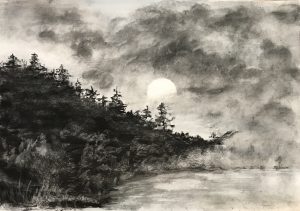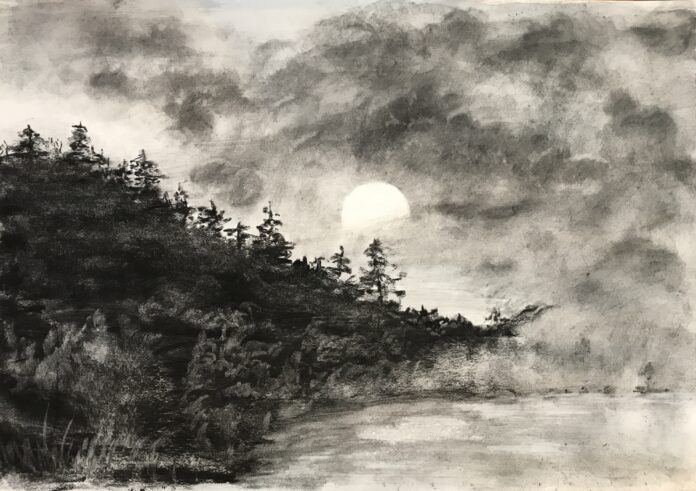BY LESLIE REGO

I love drawing with an old-fashioned dip pen and a bottle of ink. For some reason I am afraid of using a fountain pen. I guess I fear that the ink will spray over my paper and ruin my drawing. Another age-old tool I like to use is a burnt stick (my rudimentary form of carbon ink), which I grab from a campfire when I am hiking. Generally, there is enough carbon left to create a drawing.
The Greeks and Romans made ink from soot, glue and water. The ink was similar to charcoal sticks. It was very stable, but could be easily smudged and was not resistant to water. Chinese ink is made from fine soot combined with water. No binder is necessary. Shellac can be added to the ink to make it waterproof. Around 3000 B.C., the Chinese began to draw monochromatic paintings with this ink. The interest lay in creating texture and emotions through gentle strokes of black and grey.
In India, the name for black ink was “masi.” It was a mixture of ashes, water and animal glue. Europe began to import this ink in the 1700s, which is when it began to be known as India Ink.
In the Middle Ages, two kinds of black ink were used: carbon ink (India ink) and iron-gall ink made from oak galls. Iron-gall ink was used from the third century on by such artists as Leonardo da Vinci and Rembrandt van Rijn. The problem is that since the ink is made from iron salts and tannic acids, it is highly corrosive and thus not very stable.
Oak galls are ball-like shapes that reside on branches or twigs of the oak tree. They are formed by the oak gall wasp and are generally harmless. When collected, crushed, soaked in water with gum arabic and a bit of ferrous sulphate, they produce ink.
So I became curious. What other ways can I make ink from local trees? Small amounts of sap in pine trees oozes year-round, but it is particularly prevalent in the spring when new needles begin to form. This pine sap can be used to make ink. Combine a bit of the sap with gum arabic, add both to water and stir until the two are dissolved. The gum arabic thickens the liquid. Let it ferment in a jar for about a week and then strain. At this point you can add soot from a campfire or scraped from the sides of your fireplace, or even from the bottom of a pan you use for cooking over an open fire. The final color of the ink will depend upon how much soot you add. To make a deeper color, add a few rusty nails to the sap and the gum arabic during the first fermentation. With the addition of tarnished nails, the ink will darken on the paper after it is exposed to oxygen but, of course, you run the risk of having your drawing become corroded over time.
Walnuts, indigo, and peach pits have also been used to make ink. Nature has given us a lot of ways to put marks on paper. Some are more stable than others, but all are fascinating to explore.
Leslie Rego is an Idaho Press Club award-winning columnist, artist and Blaine County resident. To view more of Rego’s art, visit leslierego.com.

